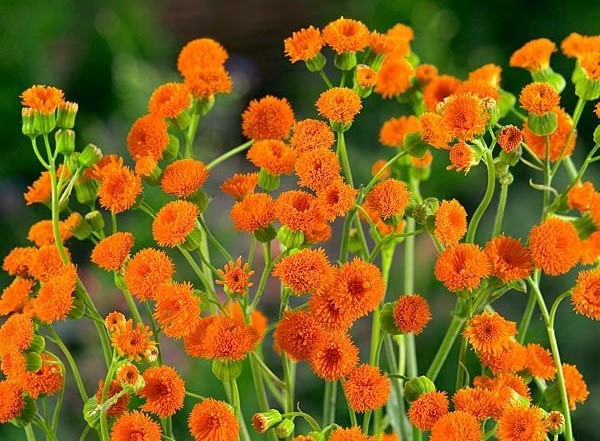Emilia coccinea

|
|
Emilia coccinea Common Names: Scarlet Tasselflower, Tassel Flower,
Flamingo Feather, Cupid’s Paintbrush Scientific
Classification Kingdom: Plantae Phylum: Angiosperms Class: Eudicots Order: Asterales Family: Asteraceae Genus: Emilia Species: E. coccinea Binomial Name: Emilia coccinea (Sims) G. Don Synonyms: Cacalia coccinea Sims, Cacalia sagittata Vahl, Emilia flammea Cass., Emilia javanica auct., Emilia sagittata (Vahl) DC. Morphological Description Emilia coccinea is an erect annual herb, typically 30–60 cm tall,
occasionally reaching 100 cm. Key features include: · Stems: Slender, branched, often hairy, green to reddish · Leaves: Lanceolate to ovate, 5–15 cm long, 2–5 cm wide, serrated or
entire, alternate · Flowers: Bright scarlet (rarely orange/pink), 1–2 cm wide, in
terminal heads, with 20–40 florets · Seeds: Pappus-bearing achenes, 3–4 mm long, dispersed by wind Its vivid blooms and
fluffy appearance make it a striking ornamental (Fern, 2023). Distribution and Habitat Emilia coccinea thrives in: · Native Range: Tropical Africa (e.g., DR Congo, Kenya, Tanzania) · Introduced Range: Asia (India, Malaysia), Australia,
Americas (Brazil, USA) · Habitat: Disturbed sites, roadsides, gardens, waste areas; prefers
full sun · Climate: Tropical/subtropical, 20–35°C, rainfall 800–2,000 mm · Soil: Well-drained, sandy to loamy, pH 5.5–7 It has naturalized
widely due to human activity and seed dispersal (PROTA, 2019). Ethnopharmacology Emilia coccinea (commonly known as red tassel flower) is a medicinal plant
with various therapeutic properties, including anti-inflammatory,
antimicrobial, antioxidant, analgesic, antidiabetic, and wound-healing effects.
It is rich in flavonoids, alkaloids, tannins, phenolics, and saponins, which
contribute to its medicinal benefits.Traditionally, Emilia coccinea has been
used to treat wounds, fevers, respiratory infections, gastrointestinal
disorders, and skin diseases. Its antimicrobial properties help combat
bacterial and fungal infections, making it effective for treating wounds and
other skin-related conditions. The plant also has antioxidant activity, which
helps protect cells from oxidative stress and supports overall health.
Additionally, it exhibits anti-inflammatory and analgesic effects, providing
relief for conditions such as arthritis and muscle pain. Some studies suggest
that Emilia coccinea has antidiabetic
potential, as it may help regulate blood sugar levels. In traditional medicine,
it is also used as a laxative and for detoxification purposes. While widely
recognized in folk medicine, further scientific research is needed to confirm
its pharmacological potential and support its use in modern medicine. · Eye Problems: Leaf infusion in Tanzania as eye drops; traditional use for
conjunctivitis (Ruffo et al., 2002). · Gastrointestinal: Leaf decoction in Nigeria for diarrhea;
methanol extract delays onset (600 mg/kg) (Owolabi et al., 2010). · Wounds: Crushed leaves in Kenya; antibacterial against E. coli (MIC 0.5 mg/mL) (Owolabi et al., 2010). · Syphilis: Root decoction in Malawi; traditional use lacks validation
(PROTA, 2019). · Chest Conditions: Root infusion in Kenya; expectorant effect
noted traditionally (Kokwaro, 1993). · Antimicrobial: Ethnomedicinal reports reveal that in Nigeria, the leaf is
use to manage or cover sores it shows antimicrobial properties against Escherichia
coli, Bacillus subtilis, Staphylococcus aureus, Pseudomonas aeruginosa,
Aspergillus niger, Penicillium notatum, and Candida albicans, exhibited
sensitivity to both extracts. Among them, the methanol extract demonstrated the
strongest antimicrobial activity, with the highest mean inhibition zone of
20.33 ± 2.73 mm against S. aureus. (Erhabor et al., 2013). ⚠ Toxicity Profile: No significant toxicity reported (LD₅₀ >
2,000 mg/kg in rats); safe in traditional doses. Overuse may cause mild stomach
upset (Owolabi et al., 2010). Additional Information · Agricultural and Gardening: Ornamental in tropics; can be weedy,
producing 1,000+ seeds/plant (Fern, 2023). · Nutrition: Young leaves occasionally eaten in Tanzania; bitter taste
limits use (Ruffo et al., 2002). · Ecological Role: Pioneer species in disturbed areas;
attracts pollinators (PROTA, 2019). References
External Links More Pictures |
|
| Compounds of Emilia coccinea | |
| References |
|